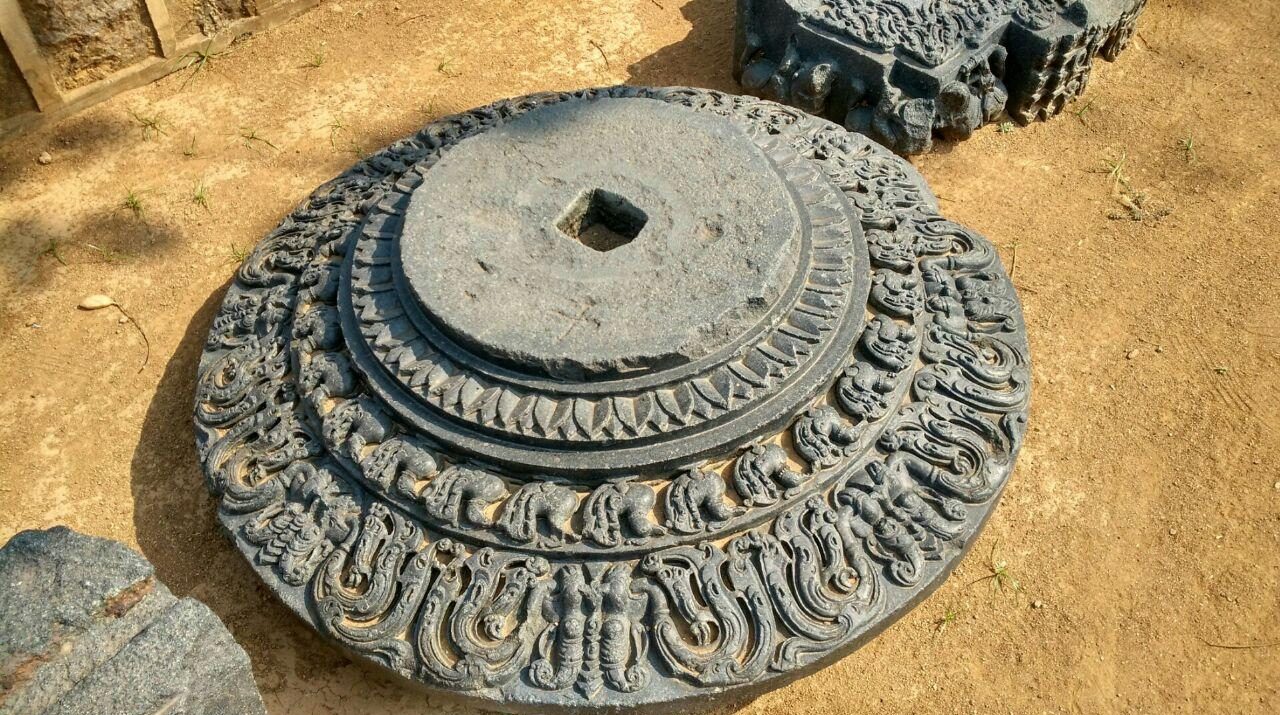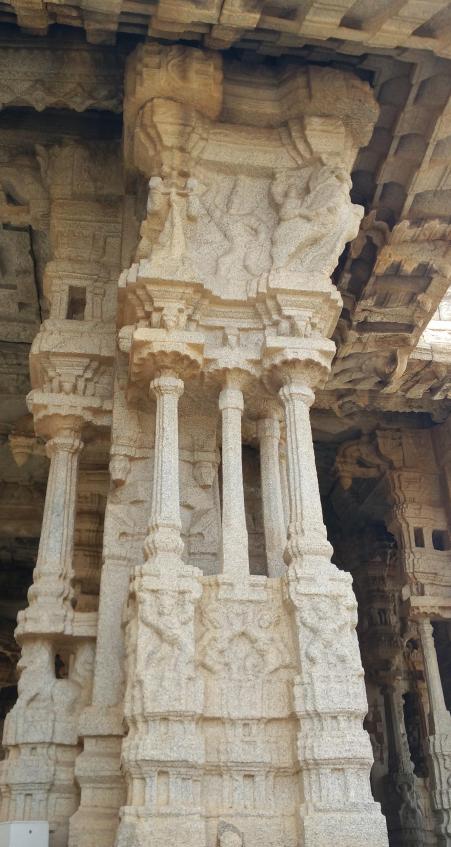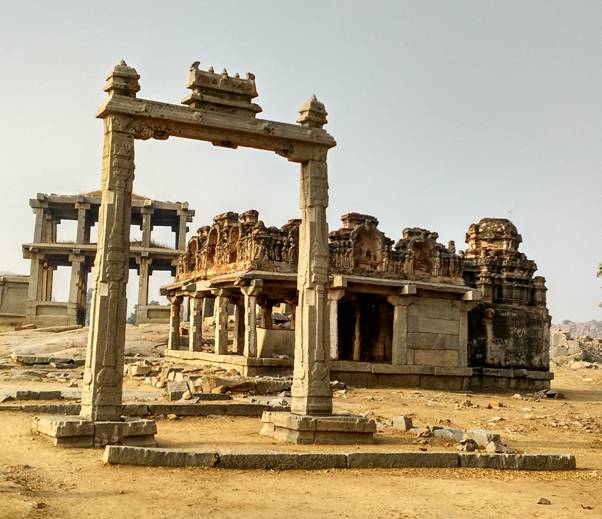The term Tadipatri means palm-leaf. It is a place in the Anantapur district in Andhra Pradesh, south of India. Tadipatri is famous for its awesome Vijayanagara temples with their style of art and architecture. Tadipatri came into prominence during Vijayanagara period. It was flourishing village during Chalukyas of Kalyani period. Vijayanagara kingdom was founded in 1336 A.D by brothers Harihara and Bukka when they declared independence from the Delhi Sultanatate. Tadipatri was developed by Nandela Viraraghavaraju. During the rule of Devaraya II Pemmasani chiefs emerged. The earliest member was Pemmasani Thimmanayudu who might have joined Vijayanagara service during Virupaksha period of 1460-85. His three sons were Ramalinganayudu, Yera Thimmanayudu and Chinna Thimmanayudu. The Bugga Ramalingeswara Swamy temple was built by Ramalinganayudu, a shrine of Lord Shiva on the bank of the River Penna, between 1490 and 1509, after he succeeded his father in governance of Yadikisima. He was a notable chief under Krishnadevaraya (1509-29).
The temple is built of granite, richly carved with the superstructures in brick and stucco. Schist stone has been used like the Hoysala temples. Schist has been used in the gateways. The temple complexes at Tadipatri are well developed having a main shrine and a devi shrine each with an open rangamandapa. The main shrines in this temple complex are of Ramalingeswara, Parvati and Lord Rama. The other smaller shrines of Chandesa and Virabhadra are to the north and south of the Ramalingeswara shrine. Closed mandapa with porches in cardinal direction is seen in the Ramalingeswara temple. The temple complex has a prakara with gopurams to the south, west and north. There is a mandapa having the navagrahas in the north-east and at the south west corner, there is a kalyanamandapa.

Carvings, Ramalingeswara temple, Tadipatri, Anantapur, Andhra Pradesh.

Carvings, Ramalingeswara temple, Tadipatri, Anantapur, Andhra Pradesh.

Carvings, Ramalingeswara temple complex, Tadipatri, Anantapur, Andhra Pradesh.
The main shrine stands on adishthana , has a mukhamndapa with porches on south and north sides, antarala and the garbagriha. The temple has rich sculpture in the niches, pillars and walls. The images of Lord Shiva include Kevalamurti in the gopura. Also images as Sukhasanamurti, Dakshinamurti, Uma-maheswaramurti,Vrsabharudamurti, Natarja,Ardhanarimurti and Bhiksatanamurti. Chandeswara is seen in a small shrine north to the main Ramalingeswara temple. The gopuras depict Parvati seen in sambhaga adorned with jewellery; the kiritamakuta,chandrakundala, kuchabandha,girdle and purnoruka. Lord Ganesha is seen in diffrent forms of Sthanakamurti and Nrityamurti or Dancing Ganesha. He is also seen as Yanakamurti or the riding form. He is seen as asanamurti or in a seated form.
 Temple view, Ramalingeswara temple, Tadipatri, Andhra Pradesh.
Temple view, Ramalingeswara temple, Tadipatri, Andhra Pradesh.
The Ramalingeswara temple has images of Kumara or Lord Murugan (Kartikeya) riding a peacock, standing or in seated position. Goddess Durga is seen depicted in the Gopura in various forms. Lord Brahma, Goddess Saraswati , Surya are also depicted. The saptamatrikas Brahmi,Vaisnavi,Indrani, Chamunda, Maheswari,Kaumaari and Varahi are seen in the open mandapa.
Lord Vishnu is seen seated on adisesa in the Ramalingeswara temple. Lord Vishnu riding on Garuda is depicted at the north gopura of the temple. Goddess Lakshmi is is depicted on the north gopura of the the Ramalingeswara temple. There is a shrine dedicated to the 12th century reformer, Ramanuja. A tall figure in the southern gopura of a noble is of the builder with a tall conical cap and short waist cloth.

Carvings, Ramalingeswara temple, Tadipatri, Anantapur, Andhra Pradesh.
The temples at Tadipatri have upapithas. The wall pattern shows bays and recesses. Doorjambs have two or three jambs, the broad jamb has salabhanjika sculpture. Ceilings are like a grid with coffers with lotus medallions or a dome having three tiers and a big pendentive. Bas reliefs are mostly found at Tadipatrit temples. In the niches smaller deity figures have been placed.

Carvings on ceiling, Ramalingeswara temple, Tadipatri, Anantapur, Andhra Pradesh.

Carvings, North gopura, Ramalingeswara temple, Tadipatri, Anantapur, Andhra Pradesh.

Carvings, Ramalingeswara temple, Tadipatri, Anantapur, Andhra Pradesh.
Hoysala artistic influence is seen in the sculpture; similar motifs, kirtimukhas, floriate arches etc. There is resemblance in the jewellery depictions too. Facial features have similar prominent eyeballs and high eyebrows. The art at Tadipatri bears resemblance to the Chennakesava temple at Pushpagiri. The temple depicts contemporary life depicting wrestlers, warriors, shepherds,hunting scenes, monkeys and horses.

Carving of salabhanjika, Ramalingeswara temple, Tadipatri, Anantapur, Andhra Pradesh.
References :
- Temples of Vijayanagara/Jayaprada, V, Delhi : Bharatiya Kala Prakashan, 1998.
- wikipedia.org
All Image attributions
- rajaraman sundaram [CC BY 3.0 (http://creativecommons.org/licenses/by/3.0)%5D, via Wikimedia Commons
Posted by :
Soma Ghosh
©author






